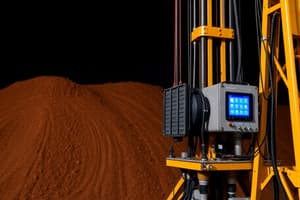Podcast
Questions and Answers
A seismologist studies ______, analyzes earthquake data, and gives reports to the world about current earthquakes.
A seismologist studies ______, analyzes earthquake data, and gives reports to the world about current earthquakes.
earthquakes
A seismograph is a tool that detects and records ______/seismic waves.
A seismograph is a tool that detects and records ______/seismic waves.
earthquakes
An epicenter is the location at which the earthquake wave first hits the ______.
An epicenter is the location at which the earthquake wave first hits the ______.
surface
A P-Wave is a type of body wave that moves in a back and forth motion, also known as ______ waves.
A P-Wave is a type of body wave that moves in a back and forth motion, also known as ______ waves.
An S-Wave, also known as shear or secondary waves, shakes the ground back and forth perpendicular to the wave direction and cannot travel through ______.
An S-Wave, also known as shear or secondary waves, shakes the ground back and forth perpendicular to the wave direction and cannot travel through ______.
Amplitude is a measure of the size of seismic waves and is related to the ______ of the earthquake.
Amplitude is a measure of the size of seismic waves and is related to the ______ of the earthquake.
What are the main responsibilities of a seismologist?
What are the main responsibilities of a seismologist?
Explain the significance of a seismograph in relation to earthquakes.
Explain the significance of a seismograph in relation to earthquakes.
Describe the characteristics of a seismogram.
Describe the characteristics of a seismogram.
What is the definition of an epicenter?
What is the definition of an epicenter?
Discuss the characteristics of P-Waves in earthquakes.
Discuss the characteristics of P-Waves in earthquakes.
Explain the properties of S-Waves in seismic activity.
Explain the properties of S-Waves in seismic activity.
Flashcards are hidden until you start studying



